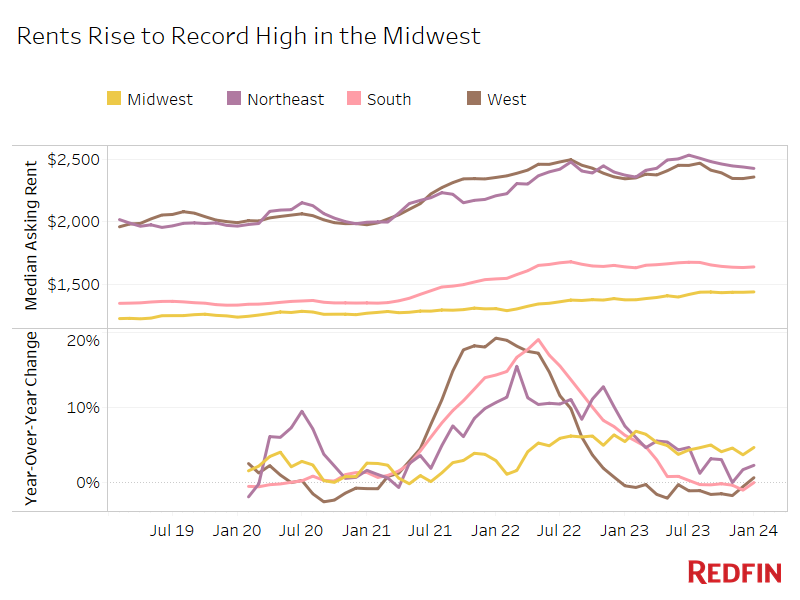Rents haven’t fluctuated much over the past year, rising 1% in January—a far cry from double-digit growth during the pandemic. Landlords don’t have much room to boost prices as they grapple with rising vacancies and the pandemic housing frenzy moves further into the rearview mirror.
The median U.S. asking rent rose 1.1% year over year to $1,964 in January, the largest annual increase since March 2023, and was unchanged from a month earlier. While rents ticked up from a year earlier, the bigger picture is that rent growth is leveling off after surging during the pandemic and then rapidly slowing from mid-2022 to mid-2023.

Year-over-year rent growth has hovered between -2.1% and +2.4% for the past year, a much narrower range than the prior year, when rent growth was as low as 4.8% and as high as 17.7%.
Asking rents have flattened because the pandemic moving frenzy is over and landlords are grappling with vacancies due to a jump in apartment supply. The rental vacancy rate was 6.6% in the fourth quarter, tied with the prior quarter for the highest level since early 2021. Vacancies have climbed due to a building boom in recent years. The number of recently completed apartments is near its highest level in more than 30 years, and the number under construction is just shy of its record high. Redfin Chief Economist Daryl Fairweather expects apartment completions to peak in 2024.
While rents have cooled, they haven’t yet posted significant declines. That’s likely because high mortgage rates continue to fuel rental demand, and because some landlords are offering one-time concessions like a free month’s rent or reduced parking costs to attract renters without having to lower asking rents on paper.
Home prices are rising much faster than rents, which is also fueling rental demand and motivating renters to stay put instead of entering the housing market.
“There’s not a huge incentive for renters to buy right now. Asking rents are stable, and while mortgage rates have dipped in recent months, they haven’t fallen enough to make the financial equation of homebuying feasible for many people,” Fairweather said. “If you’re a renter who’s interested in buying but isn’t in a rush, there’s not much downside to waiting for mortgage rates to fall and your savings to grow.”
Buying may make sense for people who can afford a large down payment and plan to stay put for at least five years, Fairweather said. Putting 20% down helps offset the cost of elevated mortgage rates and removes the cost of private mortgage insurance, and some may prefer to buy now before competition inevitably heats up when mortgage rates fall further. Of course, many Americans can’t afford a 20% down payment, though some do qualify for down payment assistance.
Rents Climb Fastest in the Midwest and Northeast
The median asking rent in the Midwest increased 4.6% year over year to a record $1,437 in January. Rents also rose in the Northeast (2.3% to $2,427) and the West (0.6% to $2,358). In the South, rents were unchanged at $1,637. The Midwest was the only region where rents hit a record high.
“Rent prices in Chicago are still out of control,” said local Redfin Premier real estate agent Dan Close. “A lot of the buyers I’m working with are people who have been pressured out of renting—if you’re paying an arm and a leg for rent, why not try to buy and build some equity? We’ll likely see this trend intensify in the spring and summer, when the vast majority of leases end.”
Rents are likely holding up best in the Midwest and Northeast because those regions haven’t been building as much as the South and West, meaning landlords aren’t under as much pressure to fill openings.
Methodology
Asking price data includes single-family homes, multi-family units, condos/co-ops and townhouses from Rent.com and Redfin.com.
Redfin has removed metro-level data from monthly rental reports for the time being as it works to expand its rental analysis.
Prices reflect the current costs of new leases during each time period. In other words, the amount shown as the median rent is not the median of what all renters are paying, but the median asking price of apartments that were available for new renters during the report month.








 United States
United States Canada
Canada